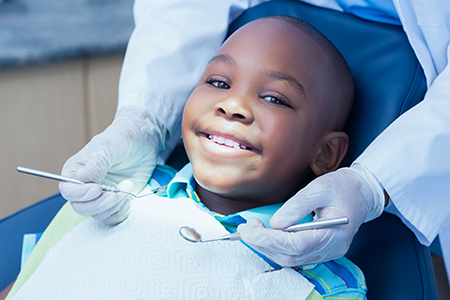
Our Office
Visit Us Online

At Frankford Dental Group, we believe every child deserves a confident, healthy smile from their very first tooth onward. Our pediatric program focuses on prevention, education, and gentle care so children learn to value oral health while parents feel supported and informed.

Early dental care sets the pattern for a lifetime of good oral health. Routine exams and cleanings help clinicians identify emerging issues long before they become painful or complex, while also giving children positive early experiences that reduce fear and build trust in the dental setting.
Our team emphasizes simple, evidence-based prevention: consistent brushing with age-appropriate fluoride toothpaste, careful flossing as teeth touch, and professionally applied protections such as sealants when appropriate. These measures work together to reduce decay risk and preserve healthy tooth structure.
We also support parents with clear, practical guidance. Whether it’s tips for establishing a nightly brushing routine, strategies to limit frequent sugary snacks, or advice on pacifier and thumb habits, our goal is to make prevention doable and effective at home.
Regular dental visits give clinicians a chance to monitor how teeth and jaws develop over time. During each exam, we evaluate tooth eruption, bite relationships, gum health, and any signs of early disease — all in a way that’s appropriate for your child’s age and comfort level.
Digital x-rays are used selectively and only when needed to see areas not visible in an oral exam, such as cavities between teeth or the position of unerupted teeth. When imaging is recommended, we discuss the purpose and safety measures to keep exposures minimal.
Professional cleanings remove plaque and polish the teeth, which both helps prevent decay and reinforces proper hygiene techniques. These visits are a chance for personalized coaching that changes as your child grows and their needs evolve.
Tooth decay remains one of the most common health issues in childhood, but it is largely preventable. Decay develops when bacteria, frequent carbohydrate exposure, and time interact — so reducing snacking frequency and improving cleaning routines can have a big impact.
Fluoride treatments and dental sealants offer additional layers of protection for vulnerable teeth. Fluoride strengthens enamel, and sealants create a barrier over the chewing surfaces of molars where food and bacteria often collect.
We partner with families to identify specific risk factors for each child and create a tailored prevention plan that balances in-office care and daily habits at home.

A child’s first impressions of the dentist shape future behavior. We design appointments to be predictable, friendly, and respectful — using age-appropriate language, visual demonstrations, and positive reinforcement to reduce anxiety and build confidence.
Some children need extra support to tolerate treatment, whether because of age, developmental differences, or previous healthcare experiences. Our team is experienced in gentle behavior management techniques and will discuss options for additional support when necessary, including safe sedation choices for specific needs.
Parents are important partners in this process. We encourage caregivers to prepare children for visits with honest, simple explanations and to model calm behavior. At the office, our staff will guide you on how to help your child get the most from each appointment.
Healthy habits at home are the backbone of pediatric dental health. Start by making brushing twice daily a family routine: short, supervised sessions with a soft-bristled brush and a smear or pea-sized amount of fluoride toothpaste depending on your child’s age.
Snack choices matter. Favor water, whole fruits, vegetables, and proteins over sticky or sugary treats that cling to tooth surfaces. Limiting sipping on sweetened beverages and replacing them with water reduces the time teeth are exposed to decay-causing sugars.
Protective measures such as properly fitted mouthguards for sports and prompt attention to dental injuries help prevent long-term problems. If you notice a toothache, swelling, or any trauma after a fall, seek prompt care so problems can be addressed before they worsen.
Start dental visits by the first birthday or when the first tooth appears
Brush twice daily with a soft brush and supervise young children until they can do a thorough job
Swap frequent juice and sugary snacks for water and balanced meals
Use recommended fluoride treatments and sealants as preventive tools when advised by your dentist
Encourage the timely transition away from bottles and assist with stopping prolonged pacifier use or thumb-sucking
Ensure protective mouthwear is used for contact sports and active play

Teeth begin forming before birth and typically start to appear in the first year of life. Early care focuses on keeping the gums and emerging teeth clean and establishing routines that support health as more teeth come in.
For infants, gently wiping the gums with a soft cloth and introducing an age-appropriate toothbrush as teeth erupt helps keep the mouth clean and familiarizes the child with brushing. The American Academy of Pediatric Dentistry recommends a first dental visit around the first birthday.
Parents should avoid letting babies sleep with bottles of milk or juice, and should minimize prolonged exposure to sugary liquids. If you have concerns about teething discomfort, feeding, or tooth appearance, discuss them with your dental provider so any necessary guidance or early interventions are available.
As children grow, their dental needs change. Baby teeth give way to permanent teeth, and facial growth can influence how the teeth align. Regular reviews allow clinicians to spot developing bite concerns and recommend timely referrals for orthodontic evaluation when appropriate.
We also watch for habits that might affect growth and alignment, such as persistent thumb sucking or prolonged pacifier use. In many cases, early counseling and simple interventions can prevent more significant problems later on.
Nutrition, school routines, sports involvement, and social changes all affect oral health during these years. Our approach is to provide practical, age-appropriate education so teens and their parents can take confident steps to protect their smiles.
Children should be evaluated for orthodontic concerns well before adolescence. Many bite problems become evident by early elementary school, and early assessment allows the care team to plan the best timing and type of treatment if needed.
We assess jaw development, tooth spacing, and bite relationships during routine visits and will discuss observations and next steps with you. When orthodontic care is recommended, we work with trusted specialists to ensure coordinated, patient-centered planning.
A balanced diet supports growing bodies and stronger teeth. Encourage calcium-rich foods, whole grains, lean proteins, and plenty of water. Limiting sticky sweets and frequent snacking reduces decay risk and supports consistent oral hygiene.
Teaching children to make smart choices about snacks and beverages helps them build healthy habits that last. Simple changes — like choosing water over juice at meals and having tooth-friendly snacks on hand — make a measurable difference in dental health.
In every stage of childhood, our priority is clear: prevent problems where possible, treat issues promptly and compassionately when they arise, and give families the tools they need to support healthy smiles. If you have questions about pediatric dental care or would like more information about our services, please contact us for more information.
A pedodontist is a dentist who has received advanced specialty training in meeting the dental needs of children from infancy to adolescence. Pedodontists, also referred to as "pediatric dentists," study child psychology, behavior management, caring for children with special needs, methods of handling oral/facial trauma, and various techniques for providing anesthesia and sedation. Pedodontists also understand the complexities of facial growth and development and have the clinical skills required to meet the dental needs of all children at every stage of development. Most of all, pedodontists are passionate about what they do and enjoy working with children. They strive to make every dental experience a positive one as they help children establish a strong foundation for good oral health.
Even before your child is born, their first set of teeth is already forming. In fact, by one year of age, some of your baby's front teeth will have already come into place. While the arrival of your baby's first teeth is only one of many developmental milestones, it represents an excellent time to begin a program of oral care. According to recommendations from the American Dental Association, babies should see the dentist around the time of their first birthdays.
Your baby's first teeth typically begin to appear in the 6 to 12-month range. While this is an extraordinary milestone, you need to be aware that your baby may find the experience a little bit uncomfortable. Teething can make babies feel irritable. They may be fussy, have trouble sleeping, not want to eat, and drool quite a bit.
Although you are powerless to speed up the process of teething, there are a few things that you can do to soothe your baby as the new teeth are erupting into place. Common approaches to helping your baby feel more comfortable while getting new teeth, include teething rings or a cold spoon or moist gauze rubbed over their gums.
Even for these few new teeth, it's absolutely essential to establish an effective regimen of oral care. For information on when your baby's first set of teeth will erupt into place, consult this timeline from the American Dental Association: Eruption Charts
Some children persist in sucking their thumbs or fingers beyond their preschool years. For these children, the activity continues to be a source of comfort, relaxation, and security. It may even help them fall asleep at night. However, it's essential to be aware that in the long-term, a finger sucking habit is not healthy.
If your child's thumb or finger sucking habit is still present when the permanent teeth begin to come in, your child is at a higher risk of developing a bad bite. By the age of five or six years, you need to constructively and gently help your child stop the habit.
It's also a good idea to have a comprehensive evaluation at this time. Your pedodontist can assess if there are any habit related alterations to the alignment of your child's teeth or jaws, or if it is affecting their speech or swallowing patterns. They can also discuss habit control strategies with you, as well as follow your child's bite and facial development as they grow. If interceptive appliances or corrective orthodontic care are recommended, the timetable and best options in care will be explained in complete detail.
The American Academy of Pediatric Dentistry recommends a first dental visit by the first birthday or within six months of the first tooth erupting. Early visits let clinicians check oral development, screen for problems, and introduce families to preventive routines that protect emerging teeth. Starting visits early also helps children become comfortable with the dental setting and establishes a regular schedule for care.
At that initial appointment the dentist will examine the gums and teeth, discuss feeding and cleaning habits, and offer guidance tailored to your child’s needs. Parents receive practical advice on brushing, pacifier use, sugar exposure, and what signs to watch for between visits. These early conversations set the foundation for long-term oral health and ongoing partnership with your dental team.
A pediatric dental exam evaluates how teeth are erupting, the relationship of the jaws, gum health, and any areas at risk for decay. The dentist or hygienist will perform a gentle exam, demonstrate brushing and flossing techniques appropriate for your child’s age, and answer questions about diet and oral habits. Cleanings remove plaque and polish the teeth to reduce decay risk and reinforce good hygiene practices.
Digital x-rays are used only when necessary to view areas not visible during the exam, such as between teeth or the position of unerupted teeth, and safety measures are discussed beforehand. Based on the exam findings, the dental team will recommend a personalized prevention plan that may include fluoride treatments, sealants, or more frequent monitoring. Parents are encouraged to be active partners in implementing recommended home care and follow-up steps.
Preventing cavities relies on consistent daily habits and targeted professional care. Brush twice daily with a soft-bristled brush and age-appropriate fluoride toothpaste, supervise flossing once teeth touch, and limit frequent snacking and sipping on sugary beverages to reduce acid exposure. A balanced diet with water and tooth-friendly snacks supports overall and dental health.
Professional measures such as fluoride treatments and dental sealants add extra protection for vulnerable teeth, especially molars with deep grooves. Regular dental visits allow clinicians to identify risk factors and tailor a prevention plan that includes coaching for home routines. Together, consistent home care and in-office prevention dramatically lower the chance of decay.
Fluoride treatments and dental sealants are widely endorsed by dental and public health organizations as safe and effective when applied appropriately. Fluoride strengthens enamel and helps prevent cavities, and topical applications in the office use controlled concentrations for short periods under professional supervision. Sealants create a physical barrier over the chewing surfaces of molars, protecting pits and fissures where food and bacteria tend to collect.
Your child’s dentist will assess individual risk factors such as tooth anatomy, decay history, and oral hygiene to determine whether these preventive measures are recommended. Providers follow established guidelines to ensure safe use of fluoride and proper placement of sealants, and they will explain the expected benefits and any follow-up care needed. When advised, these tools are valuable additions to daily brushing and healthy dietary habits.
Many children feel nervous about dental visits, and pediatric teams use age-appropriate communication, visual demonstrations, and positive reinforcement to make appointments predictable and comforting. Calm explanations, child-friendly language, and step-by-step previews of procedures reduce uncertainty and build trust. Staff members are trained in behavior guidance techniques to support cooperation while respecting each child’s pace and comfort.
For children who need extra support due to age, developmental differences, or past experiences, the team will discuss additional options to ensure safe, effective care. When necessary and appropriate, minimal or moderate sedation may be considered and is administered under established safety protocols with parent consent. Parents play an important role by preparing children with honest, simple explanations and modeling calm behavior before and during visits.
Sucking is a natural soothing behavior in infancy and early toddlerhood, but persistent thumb sucking or pacifier use beyond age 3 to 4 can affect dental development and the alignment of permanent teeth. The timing varies by child, and many habits resolve on their own; however, prolonged sucking that changes tooth position or jaw growth should prompt observation and discussion with the dentist. Early counseling increases the chance of a smooth transition away from the habit.
Strategies to help children wean include gentle positive reinforcement, shifting attention during known triggers, and setting gradual goals rather than abrupt punishment. In cases where the habit persists and begins to affect the bite, the dentist may recommend behavioral techniques or referrals to specialists for additional support. The focus is on supportive, age-appropriate approaches that protect dental development while minimizing stress for the child and family.
Care for baby teeth begins before the first tooth appears by wiping the gums gently with a soft cloth after feedings to remove bacteria and sugars. When teeth erupt, introduce a soft, age-appropriate toothbrush and use a smear or pea-sized amount of fluoride toothpaste according to age-specific guidelines. Supervise brushing to ensure effective cleaning and to build a routine that becomes a lifelong habit.
Avoid letting babies fall asleep with bottles containing milk or juice, and limit prolonged exposure to sugary liquids, as these practices increase the risk of early childhood caries. If your baby has teething discomfort, simple measures such as chilled teething rings or gentle gum massage often provide relief; discuss severe or persistent symptoms with the dental team. Early preventive care and healthy feeding practices help protect primary teeth until they are naturally replaced.
An early orthodontic evaluation is often recommended by the first permanent molars and incisors erupting, typically around ages 6 to 8, and again during the early teen years, though timing depends on individual development. Routine dental visits allow clinicians to monitor jaw growth, spacing, and bite relationships and to identify signs that early intervention might reduce future complexity. Many bite problems are easier to correct when growth is favorable, so timely assessment can improve long-term outcomes.
If the dental team notices issues such as severe crowding, crossbites, or asymmetrical jaw growth, they will discuss the possible benefits and timing of a referral to an orthodontic specialist. Coordination between the general dentist and orthodontist ensures a patient-centered plan that considers dental health, facial growth, and the child’s emotional readiness. Parents are guided through monitoring steps and indicators that warrant a specialist evaluation.
In the event of a dental injury, staying calm and acting promptly improves the chances of a favorable outcome. For a knocked-out permanent tooth, try to handle the tooth by the crown only, rinse it gently if dirty, and attempt to reinsert it into the socket if possible, or preserve it in milk or saline and seek immediate professional care. For primary (baby) teeth that are knocked out, contact the dentist for guidance rather than attempting reinsertion, since treatment goals differ for primary versus permanent teeth.
For chipped, cracked, or loose teeth, apply a cold compress to control swelling and limit activity until the child can be evaluated. Contact the dental office promptly so the care team can recommend next steps and arrange an urgent appointment if needed; if immediate help is needed, call the office at (800) 416-5235 for instructions. Quick assessment and appropriate treatment reduce the risk of infection and long-term complications after dental trauma.
Sports mouthguards are an effective way to reduce the risk of tooth fractures, soft tissue injuries, and jaw trauma during contact and high-impact activities. Mouthguards absorb and distribute force, protecting both teeth and surrounding structures, and are recommended whenever children participate in organized sports or recreational activities where collisions or falls are possible. Consistent use of a well-fitting mouthguard significantly lowers the likelihood of dental emergencies.
Options include stock, boil-and-bite, and custom-fitted mouthguards, with custom devices offering superior fit, comfort, and protection because they are made from impressions of the child’s teeth. Your dentist can advise on the best type for your child’s sport and activity level and, when appropriate, provide or order a custom mouthguard to ensure proper fit and durability. Regular inspection and timely replacement maintain effective protection as your child grows.
Available after hours by appointment.
